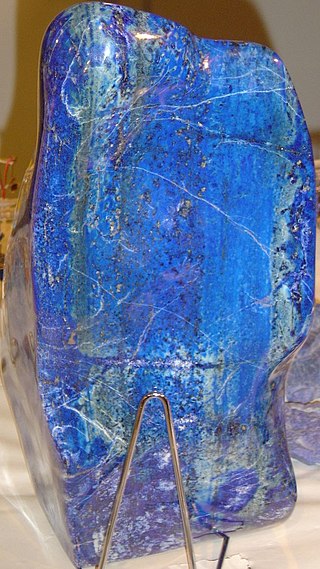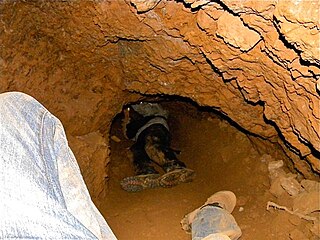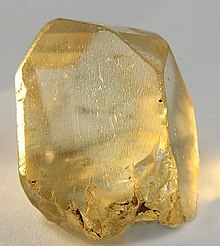
Mining is the extraction of valuable geological materials and minerals from the surface of the Earth. Mining is required to obtain most materials that cannot be grown through agricultural processes, or feasibly created artificially in a laboratory or factory. Ores recovered by mining include metals, coal, oil shale, gemstones, limestone, chalk, dimension stone, rock salt, potash, gravel, and clay. The ore must be a rock or mineral that contains valuable constituent, can be extracted or mined and sold for profit. Mining in a wider sense includes extraction of any non-renewable resource such as petroleum, natural gas, or even water.

NMDC Limited, formerly National Mineral Development Corporation, is an Indian public sector undertaking involved in the exploration of iron ore, copper, rock phosphate, limestone, dolomite, gypsum, bentonite, magnesite, diamond, tin, tungsten, graphite, coal etc. It is India's largest iron ore producer and exporter, producing more than 35 million tonnes of iron ore from three mechanized mines in Chhattisgarh and Karnataka. It also operates the only mechanized diamond mine in the country at Panna in Madhya Pradesh.

Mining in Australia has long been a significant primary sector industry and contributor to the Australian economy by providing export income, royalty payments and employment. Historically, mining booms have also encouraged population growth via immigration to Australia, particularly the gold rushes of the 1850s. Many different ores, gems and minerals have been mined in the past and a wide variety are still mined throughout the country.

Mining in Western Australia, together with the petroleum industry in the state, accounted for 94% of the State's and 46% of Australia's income from total merchandise exports in 2019–20. The state of Western Australia hosted 123 predominantly higher value and export-oriented mining projects and hundreds of smaller quarries and mines. The principal projects produced more than 99 per cent of the industry's total sales value.
Iron ore production in Africa is dominated by South Africa, Mauritania and Algeria. Many countries possess iron ore deposits that are as yet untapped/unmined. Countries and companies currently involved in production are listed here; measurements are in tonnes per annum(year).

Mining in Iran is still under development, yet the country is one of the most important mineral producers in the world, ranked among 15 major mineral-rich countries, holding some 68 types of minerals, 37 billion tonnes of proven reserves and more than 57 billion tonnes of potential reserves worth $770 billion in 2014. Mineral production contributes only 0.6 percent to the country's GDP. Add other mining-related industries and this figure increases to just four percent (2005). Many factors have contributed to this, namely lack of suitable infrastructure, legal barriers, exploration difficulties, and government control.

The mining industry of the Democratic Republic of the Congo produces copper, diamonds, tantalum, tin, gold, and more than 63% of global cobalt production. Minerals and petroleum are central to the DRC's economy, making up more than 95% of the value of its exports.

The Mining industry of Ghana accounts for 5% of the country's GDP and minerals make up 37% of total exports. Gold contributes over 90% of the total mineral exports. Thus, the main focus of Ghana's mining and minerals development industry remains focused on gold. Ghana is Africa's largest gold producer, producing 80.5 t in 2008. Ghana is also a major producer of bauxite, manganese and diamonds. Ghana has 20 large-scale mining companies producing gold, diamonds, bauxite and manganese; over 300 registered small scale mining groups; and 90 mine support service companies.Other mineral commodities produced in the country are natural gas, petroleum, salt, and silver.
Burundi is a producer of columbium (niobium) and tantalum ore, tin ore, and tungsten ore, and some deposits of gold which are designated for export. Burundi has resources of copper, cobalt, nickel, feldspar, phosphate rock, quartzite, and rare reserves of uranium, and vanadium. The country is also a producer of limestone, peat, sand and gravel for domestic consumption and as building materials. As of 2005, manufacturing accounted for 8% of the country's gross domestic product.
The regulation of mining in Equatorial Guinea is handled by the Ministry of Mines, Industry, and Energy, which oversees activities in the mining and petroleum industries.

Mining in Afghanistan was controlled by the Ministry of Mines and Petroleum, prior to the August 15th takeover by the Taliban. It is headquartered in Kabul with regional offices in other parts of the country. Afghanistan has over 1,400 mineral fields, containing barite, chromite, coal, copper, gold, iron ore, lead, natural gas, petroleum, precious and semi-precious stones, salt, sulfur, lithium, talc, and zinc, among many other minerals. Gemstones include high-quality emeralds, lapis lazuli, red garnet and ruby. According to a joint study by The Pentagon and the United States Geological Survey, Afghanistan has an estimated US$1 trillion of untapped minerals.

The mineral industry is one of the main sectors of the Armenian economy and in 2017 accounted for 30.1% of its exports.
The mineral industry of Russia is one of the world's leading mineral industries and accounts for a large percentage of the Commonwealth of Independent States' production of a range of mineral products, including metals, industrial minerals, and mineral fuels. In 2005, Russia ranked among the leading world producers or was a significant producer of a vast range of mineral commodities, including aluminum, arsenic, cement, copper, magnesium compounds and metals, nitrogen, palladium, silicon, nickel and vanadium.
The second-largest mineral industry in the world is the mineral industry of Africa, which implies large quantities of resources due to Africa being the second largest continent, with 30.37 million square kilometres of land.With a population of 1.4 billion living there, mineral exploration and production constitute significant parts of their economies for many African countries and remain keys to economic growth. Africa is richly endowed with mineral reserves and ranks first in quantity of world reserves for bauxite, cobalt, industrial diamond, phosphate rock, platinum-group metals (PGM), vermiculite, and zirconium.

Mining is the biggest contributor to Namibia's economy in terms of revenue. It accounts for 25% of the country's income. Its contribution to the gross domestic product is also very important and makes it one of the largest economic sectors of the country. Namibia produces diamonds, uranium, copper, magnesium, zinc, silver, gold, lead, semi-precious stones and industrial minerals. The majority of revenue comes from diamond mining. In 2014, Namibia was the fourth-largest exporter of non-fuel minerals in Africa.

The mineral mining industry is a crucial piece of the Economy of Niger. Exports of minerals consistently account for 40% of exports.
Resources are classified as either biotic or abiotic on the basis of their origin. India contains a multitude of both types of resource and its economy, especially in rural areas, is heavily dependent on their consumption or export. Due to overconsumption, they are rapidly being depleted.
Mauritania's mineral sector was dominated by iron ore mining and beneficiation. Other mineral commodities produced in the country included cement, copper, gold, gypsum, petroleum, salt, and steel. The Ministère des Mines et de l’Industrie was the Government agency responsible for enacting the Mining Code and for the coordination of all activities in the mining sector. The Direction des Mines et de la Géologie was the entity responsible for promoting the mineral sector and for providing geologic and mining information to potential investors; the Direction des Hydrocarbures was in charge of the development of the petroleum sector; and the Office Mauritanien des Recherches Géologiques was the Government entity responsible for evaluating areas of mineral potential for exploration. Société Nationale Industrielle et Minière (SNIM) was responsible for iron ore production and benefciation.

An artisanal miner or small-scale miner (ASM) is a subsistence miner who is not officially employed by a mining company, but works independently, mining minerals using their own resources, usually by hand.

Ajaokuta Steel Company Limited (ASCL) popularly known as Ajaokuta Steel Mill is a steel mill in Nigeria, located in Ajaokuta, Kogi State, Nigeria. Built on a 24,000 hectares (59,000 acres) site starting in 1979, it is the largest steel mill in Nigeria, and the coke oven and by-products plant are larger than all the refineries in Nigeria combined. However, the project was mismanaged and remains incomplete 40 years later. Three-quarters of the complex have been abandoned, and only the light mills have been put into operation for small-scale fabrication and the production of iron rods.














